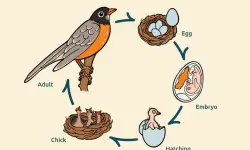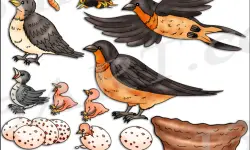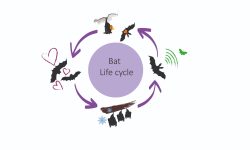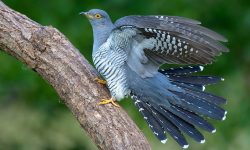Alabama’s forests, wetlands, and rural landscapes are home to a colorful and diverse group of woodpeckers. From the iconic Pileated Woodpecker with its flaming red crest to the endangered Red-cockaded Woodpecker, this southeastern state offers birdwatchers excellent opportunities to observe these tree-dwelling drummers. In this guide, we’ll explore the nine woodpecker species commonly seen in Alabama, complete with descriptions, habitat preferences, and tips for identification.
Red-bellied Woodpecker (Melanerpes carolinus)

Appearance and Key Features
At first glance, the Red-bellied Woodpecker might seem misnamed—its belly bears only a subtle flush of red that’s easy to miss. But there’s no mistaking this bird once you spot its bold, zebra-striped back and striking red cap. In males, the red stretches from the beak all the way down the nape, while females wear a more modest red patch limited to the back of the head. Their stout, wedge-shaped bill and pale, grayish face round out a look that’s both vivid and unmistakable in the Southeast’s woodlands.
Habitat in Alabama
One of Alabama’s most common and widespread woodpeckers, the Red-bellied thrives in a wide range of habitats. It’s equally at home deep in hardwood forests, patrolling the trunks of oak and hickory, or visiting backyard feeders in Birmingham suburbs. Mature trees—dead or alive—are key, providing both nesting cavities and rich foraging grounds.
Behavior and Sounds
Red-bellied Woodpeckers are chatty, curious, and conspicuous. Their rolling, rattling “churr-churr” calls often echo through woodlands before the bird itself is seen. These woodpeckers frequently drum on tree trunks, metal poles, or even gutters, using sound to communicate and stake territory. They are opportunistic omnivores, feeding on beetles, ants, spiders, fruits, nuts, and even the occasional lizard or small bird egg. In winter, they’re loyal visitors to suet feeders, and in summer, they’re busy caching acorns and berries in tree bark for leaner days.
Downy Woodpecker (Dryobates pubescens)

Appearance and Key Features
Tiny but tenacious, the Downy Woodpecker holds the title of Alabama’s smallest woodpecker. Despite its size, it boasts a bold and charming appearance: crisp black-and-white wings dotted with speckles, a bright white belly, and a snowy white patch running down its back. Males are distinguished by a tiny splash of red on the back of the head, while females lack this feature. Its short, stubby bill is proportionally smaller than that of any other North American woodpecker—a key detail that helps set it apart from its close cousin, the Hairy Woodpecker.
Habitat in Alabama
This feathered acrobat is found across Alabama year-round, thriving in both rural and urban settings. Whether it’s flitting through a quiet hardwood forest, exploring a city park, or tapping away at the bark of a backyard tree, the Downy Woodpecker is one of the most approachable and frequently spotted woodpeckers in the state. It’s especially fond of wooded edges, gardens, and areas with standing dead trees.
Behavior and Sounds
Agile and unafraid, the Downy can often be seen climbing nimbly along slender twigs and stems that would never support a larger woodpecker. It feeds on a wide variety of insects, particularly ants and caterpillars, as well as seeds and berries, and is a regular visitor to suet and peanut feeders. Its call is a sharp, high-pitched “pik!”—like a squeaky toy in the woods—and its drumming, though rapid and light, carries surprisingly far. This combination of endearing size, curiosity, and vocal personality makes the Downy one of Alabama’s most beloved backyard birds.
Hairy Woodpecker (Dryobates villosus)

Appearance and Key Features
At first glance, the Hairy Woodpecker looks nearly identical to the Downy, but a closer look reveals key differences. Larger and sturdier overall, the Hairy has a chisel-like bill nearly as long as its head—much longer in proportion than the Downy’s. Its plumage is a striking pattern of black and white: a white belly and back, jet-black wings speckled with white, and in males, a red patch on the rear crown. A subtle but telling clue lies in the outer tail feathers—on the Hairy, they are solid white, lacking the black spots that dot the Downy’s.
Habitat in Alabama
In Alabama, the Hairy Woodpecker prefers the quiet depths of mature forests, especially those with large, dead trees and snags ideal for excavation. It is less common in suburban environments and gardens than the adaptable Downy but may still show up in well-wooded parks or natural preserves. Old-growth woodlands, riparian corridors, and pine-hardwood forests are some of its favored haunts.
Behavior and Sounds
More secretive and deliberate in its movements, the Hairy Woodpecker tends to stay higher in the canopy or deeper in the woods, hammering away at bark with slow, powerful blows. Its drumming is louder, more resonant, and spaced more evenly than the Downy’s quickfire taps. A skilled hunter, it specializes in extracting wood-boring insects, especially beetle larvae, from deep within trunks and limbs. Its sharp “peek!” call is sharper and lower-pitched than the Downy’s, and while it rarely visits feeders, it may come to suet during the colder months if natural food is scarce.
Northern Flicker (Colaptes auratus)
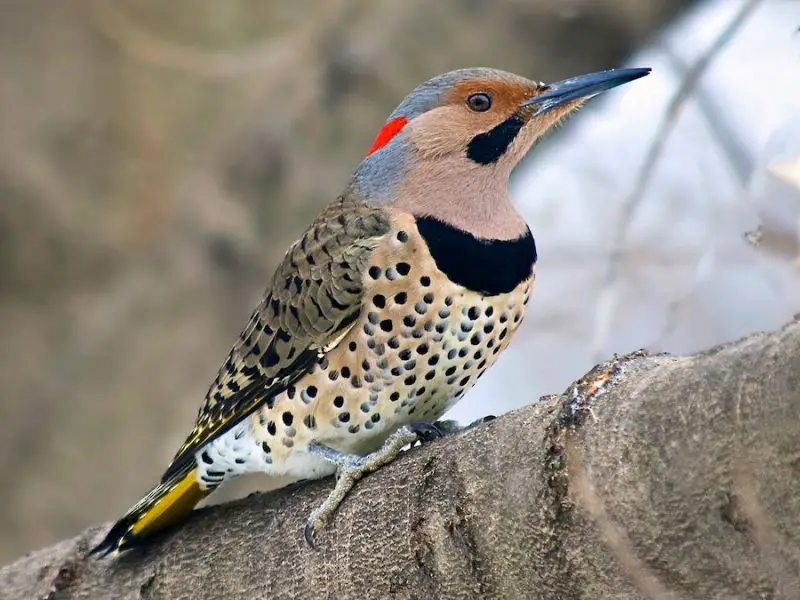
Appearance and Key Features
Among Alabama’s woodpeckers, the Northern Flicker stands out as a beautifully patterned oddball. Rather than clinging high on tree trunks like its cousins, this elegant bird often patrols the forest floor. Flickers in Alabama belong to the Yellow-shafted group, which is easily recognized by its golden-yellow underwings and tail feathers, especially when the bird takes flight. Its back is brown with black barring, its belly pale and covered in distinct black spots, and a bold black bib accents its chest. Males can be told apart by a sharp black “mustache” mark stretching from the beak along the cheek—females lack this detail.
Habitat in Alabama
Northern Flickers are widespread across Alabama and surprisingly versatile in their habitat preferences. You’re just as likely to see one pecking through leaf litter on a quiet forest trail as you are on the edge of a manicured golf course. They favor open woodlands, forest edges, fields with scattered trees, and even urban parks. Unlike most woodpeckers, flickers have embraced ground foraging as a lifestyle.
Behavior and Sounds
With their long, slightly curved bills, flickers dig into soil and decaying wood, searching for their favorite prey: ants and beetles. Their long, barbed tongues can slurp insects straight from underground tunnels. While they occasionally drum, they’re more often detected by ear than eye—listen for their loud, ringing “kleer!” call or the rapid, yelping laugh that sounds like a cross between a cackle and a bird’s chuckle. Their erratic, swooping flight and golden wing flashes make them instantly recognizable in the air. Social, curious, and uncommonly elegant, the Northern Flicker adds variety and flair to Alabama’s woodpecker scene.
Pileated Woodpecker (Dryocopus pileatus)

Appearance and Key Features
Majestic, unmistakable, and almost prehistoric in its presence, the Pileated Woodpecker is the largest woodpecker in Alabama—and one of the most dramatic birds in all of North America. About the size of a crow, it boasts a fiery red crest that flares like a flamethrower above its jet-black body. Sharp white stripes slash across the face and neck, adding contrast and intensity to its already striking appearance. Males are distinguished by a bright red “mustache” stripe along the cheek, which females lack. When you see this bird flying through the woods with its powerful, undulating wingbeats and flashing white underwings, it leaves no doubt that you’re witnessing something truly wild.
Habitat in Alabama
Pileated Woodpeckers are permanent residents throughout Alabama, but they require large, mature forests to thrive—especially those with a healthy supply of standing dead trees (snags) and fallen logs. They favor bottomland hardwood forests, upland pine-oak woodlands, and remote riparian corridors, where human disturbance is minimal and the insect population is robust. Though shy and elusive, they occasionally venture near rural yards or natural parks with extensive forest cover.
Behavior and Sounds
If you hear a deep, reverberating “wuk-wuk-wuk” echoing through the trees, stop and look up—you may be close to a Pileated Woodpecker. Their drumming is thunderous, often sounding like someone hitting wood with a hammer. These woodpeckers are expert excavators, chiseling massive rectangular holes into dead trees in search of their favorite meal: carpenter ants and wood-boring beetle larvae. The size of these cavities often dwarfs the bird itself and provides vital shelter for other wildlife, including owls, squirrels, and nesting ducks. Though wary of humans, Pileateds can be surprisingly vocal and visible when defending a territory or feeding.
In the deep woods of Alabama, the Pileated Woodpecker is a symbol of undisturbed wilderness—its echoing call a heartbeat of the forest itself.
Red-headed Woodpecker (Melanerpes erythrocephalus)

Appearance and Key Features
A living burst of color and contrast, the Red-headed Woodpecker is among the most visually arresting birds in North America—and it earns its name without apology. Adults are unmistakable, sporting a solid crimson head that gleams in the sunlight like polished lacquer. This vibrant red is sharply offset by a snow-white belly and jet-black wings adorned with large, bold white patches that flash in flight. Juveniles, in contrast, have brownish heads and mottled backs, making their transformation into full adult plumage all the more dramatic.
Habitat in Alabama
This species favors open woodlands, especially those dotted with standing dead trees, which are crucial for both nesting and foraging. It thrives in pine savannas, oak groves, orchards, and even semi-cleared agricultural areas. In Alabama, its distribution is patchy and subject to change—closely tied to the availability of food and suitable nesting trees. Regions with regular prescribed burns or natural fire regimes, such as the Black Belt prairie and longleaf pine ecosystems, offer the most stable habitats.
Behavior and Sounds
The Red-headed Woodpecker is a versatile forager and one of the few woodpeckers in North America that stores food for later use. It will wedge acorns, nuts, and even insects into tree bark crevices, fence posts, or utility poles. It’s also an adept insect-hawker, flying out from perches to snatch beetles, wasps, and moths mid-air—a behavior more typical of flycatchers than woodpeckers. Their calls are sharp, dry “churr” notes—short and abrupt, yet distinctive once learned.
Though stunning in appearance, the Red-headed Woodpecker is also a species of concern. Populations have declined across much of its range due to habitat loss, especially the removal of dead trees and suppression of natural fires. In Alabama, its presence is both a visual delight and a conservation reminder: beautiful birds need wild, dynamic landscapes to thrive.
Yellow-bellied Sapsucker (Sphyrapicus varius)

Appearance and Key Features
Despite its quirky name, the Yellow-bellied Sapsucker is a subtle stunner among Alabama’s winter woodpeckers. This medium-sized species wears a finely patterned outfit: a black-and-white face with distinct stripes, a pale yellow belly, and a crisp white wing patch visible in flight. The crown is bright red in both sexes, while males also sport a red throat—a helpful clue for field identification. Its plumage is mottled enough to blend into tree bark, making it surprisingly stealthy for a bird with such a bold name.
Habitat in Alabama
Unlike year-round residents like the Red-bellied or Downy Woodpecker, the Yellow-bellied Sapsucker is a winter visitor in Alabama. It arrives from its northern breeding grounds in Canada and the upper U.S. as early as October and stays through March or April. During this time, it prefers deciduous forests, wooded ravines, orchards, and areas rich in sap-producing trees like maples, birches, and fruit trees. Well-wooded parks and suburban neighborhoods with mature trees can also host these elusive birds in colder months.
Behavior and Sounds
True to its name, this woodpecker feeds not by drilling deep into wood for insects, but by tapping shallow holes into bark to access flowing sap. It creates orderly rows of small, round wells and revisits them regularly to lap up the sweet liquid, often catching ants and other insects drawn to the sticky sap. Their feeding trees are easy to spot—bands of neatly drilled holes often circle the trunk.
The Yellow-bellied Sapsucker’s call is a nasal, catlike “mew”, quite different from the sharper cries of other woodpeckers. Its drumming is equally distinctive: a stuttering, uneven rhythm with long pauses between bursts. Though not flashy or loud, its subtle beauty and fascinating feeding behavior make it a prized winter sighting for birders in Alabama.
Red-cockaded Woodpecker (Dryobates borealis)

Appearance and Key Features
Slight in size but great in ecological significance, the Red-cockaded Woodpecker is a striking little bird cloaked in crisp black-and-white. Its back is barred like a ladder, its cheeks are white and framed by a dark cap and neck, and males display a subtle, narrow red streak—or “cockade”—behind the eye, which is often hidden and hard to spot in the field. Unlike many flashier woodpeckers, this species leans into subtlety, but it’s no less iconic for it.
Habitat in Alabama
This woodpecker is one of the South’s true pine forest specialists—and a flagship species for endangered habitat conservation. In Alabama, it lives almost exclusively in mature longleaf pine ecosystems, which once covered vast areas of the coastal plain but have now been reduced to fragments. Prime habitats include the Conecuh National Forest, Talladega National Forest, and military lands like Fort Novosel (formerly Fort Rucker). These birds depend on pine trees that are at least 60–80 years old, especially those with red heart rot that make cavity excavation easier.
Behavior and Sounds
Red-cockaded Woodpeckers are highly social and unique in many ways. Unlike most woodpeckers, which excavate nest cavities in dead trees, this species drills its home in living pines—a labor-intensive process that can take months to complete. They also tap into the tree’s resin canals, creating a sticky flow of sap around the cavity entrance, which deters climbing predators like snakes.
Even more remarkable is their cooperative breeding system: offspring often remain with their parents as helpers, assisting in raising younger siblings and defending the territory. A typical group consists of a breeding pair and one to several helper birds, all working together to feed nestlings and maintain roosting cavities.
Their calls are soft, nasal notes and chatters—less piercing than those of other woodpeckers—and their drumming is relatively quiet. Spotting one requires patience, knowledge of longleaf pine habitats, and often, the help of trained biologists.
Conservation Significance
Federally listed as endangered, the Red-cockaded Woodpecker is a symbol of both ecological decline and recovery. Thanks to decades of habitat management, prescribed fire, and artificial cavity installation, its populations in Alabama are slowly rebounding. Still, it remains a conservation-reliant species, one that speaks volumes about the health of an entire ecosystem.
To glimpse this bird is to witness the success of intentional stewardship—and to step into one of Alabama’s rarest and most biologically rich landscapes.
Ivory-billed Woodpecker (Campephilus principalis) – Possibly Extinct

Appearance and Key Features
Once the undisputed monarch of southern forests, the Ivory-billed Woodpecker teeters on the edge of legend. If it still exists, it would be second in size only to the Pileated Woodpecker—but far more striking. This majestic bird was known for its bright ivory-white bill, enormous white wing panels, and bold black-and-white facial markings. Males bore a brilliant crimson crest, while females wore one of black. When in flight, the species revealed extensive white trailing edges along the wings, a flashing signature in the swampy gloom of its habitat.
The overall impression was one of power, contrast, and drama—no other woodpecker looked quite like it.
Historical Presence in Alabama
The Ivory-billed Woodpecker once roamed the swampy bottomlands and cypress-tupelo forests of Alabama, particularly in the southern and southwestern portions of the state. It was most at home in deep, wet, old-growth forests where massive, dying trees provided food and shelter. By the mid-20th century, however, it had vanished from confirmed sight, its habitat devastated by unchecked logging and river channelization. Though sporadic, unconfirmed sightings have been reported in Alabama and neighboring states—especially in the Choctawhatchee River region of Florida—no clear photographic or audio evidence has substantiated its continued existence.
In Alabama, it remains a ghost: remembered by a handful of elders, pursued by hopeful birders, and mourned by conservationists.
Behavior and Conservation Status
Historically, Ivory-billed Woodpeckers fed on wood-boring beetle larvae, chiseling deep into the trunks of dead or dying trees with their powerful, pale bills. They preferred forests rich in decay—ecosystems now almost entirely erased. Their calls were said to resemble a tin trumpet—a resonant, nasal “kent-kent” that echoed like no other sound in the southern woods. Their drumming was described as loud and single-tapped, very different from the rapid bursts of smaller species.
Today, the Ivory-billed Woodpecker is listed as Critically Endangered (Possibly Extinct) by the IUCN, and Presumed Extinct by the U.S. Fish & Wildlife Service—although final delisting has been delayed due to ongoing reports and public pressure. The loss of this bird has become symbolic of an entire generation of vanished wilderness in the American South.
A Legacy of Loss and Hope
To speak of the Ivory-bill in Alabama is to speak of what once was—a cathedral of towering trees, a bird as bold as thunder, and a landscape now fragmented beyond recognition. But it is also to speak of the value of wildness, the power of restoration, and the enduring hope that somewhere, deep in a forgotten swamp, one of these magnificent woodpeckers still drums on a hollow tree.
Even in probable absence, the Ivory-billed Woodpecker continues to inspire generations of birders, naturalists, and forest stewards—to protect what remains and to imagine what might still be found.
Conclusion: Alabama’s Woodpecker Diversity Is Worth Watching
From backyard feeders to remote pine forests, Alabama offers a wide range of habitats for woodpeckers. Whether you’re watching a Downy Woodpecker tap delicately on an oak tree or marveling at the thunderous drumming of a Pileated Woodpecker, each species contributes uniquely to the ecosystem. Their role in insect control, forest regeneration, and even cavity creation for other animals makes them invaluable members of the avian community.
For birders and conservationists alike, understanding these nine species is the first step toward appreciating and protecting Alabama’s rich woodpecker heritage.

